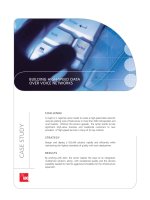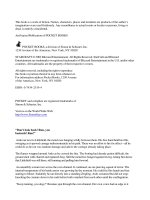Compliance at speed
Bạn đang xem bản rút gọn của tài liệu. Xem và tải ngay bản đầy đủ của tài liệu tại đây (1.04 MB, 42 trang )
Compliance at Speed
Achieving Performance in Enterprise Applications
Mark Lustig
Introduction
In many industries today, adhering to regulations is not optional; it is
mandatory. As information technology professionals, we are constantly
challenged with tight timelines for building and enhancing information
systems, not just to provide new functionality, but also to ensure our systems
meet the guidelines and standards for each industry.
Compliance Affects Everyone, Not Just the
Big Banks
Compliance impacts all industries, and is becoming more important every
day. Highly regulated industries including financial services and health care
must meet strict standards for compliance. For online retailers, privacy and
security standards must also be met. The social networking industry is facing
regulations specific to consumer protection and the use of customer
information.
No industry is immune to meeting compliance requirements, and emerging
regulations create more challenges to achieving performance objectives each
year, both domestically and internationally. Any website that uses, stores, or
processes personal or payment information must address these challenges,
notably for security and the payment card industry (PCI), but also for
accessibility,access controls, confidentiality, and audit purposes.
Staying abreast of techniques to meet performance goals and compliance
regulations is an emerging trend within both performance engineering (PE)
and DevOps. Conferences such as Velocity are addressing these topics both
tactically and strategically. Tactical, cutting-edge techniques are taking into
account the needs of high-tech and web-facing companies as well as large
Fortune® 500 enterprises. Strategically, the emerging cultural paradigm of
DevOps is becoming more prominent at larger companies, across complex
architectures that include legacy systems.
Performance Is Mandatory for
Competitiveness and Business Success
Today’s complex system architectures include rich user interfaces, the ability
to execute complex business transactions quickly, and the need to provide
critical information to users in a variety of formats, both desktop and mobile.
How do you ensure you can meet business goals when the system is made up
of a combination of web servers, application servers, and multiple
middleware layers, including interfaces to web services, databases, and
legacy systems? How do you achieve performance goals while meeting
regulatory requirements such as multifactor authentication, encryption, and
storing years’ worth of online transactional data? System designers and
architects must understand and manage the performance impacts of mandated
features to ensure that service levels can be maintained.
In an effort to accelerate the timelines in providing new systems and
enhancing functionality, we’re moving from the classic software
development methodologies of the past to methodologies based on
continuous deployment. Adoption of agile and continuous integration and
deployment models enables system functionality to be released more quickly,
without sacrificing quality. Regulated industries are struggling to adopt these
methodologies, as long-standing release management and testing processes
are slow to adapt to accelerated delivery models.
The trend of ubiquitous access is putting more pressure on system
performance. Access patterns and user behavior are changing. The mix of
concurrent types of users and concurrent access is also forcing a change in
how systems are designed to support these emerging trends. We must build
systems to achieve performance for all users executing business-critical
transactions, regardless of whether a particular user is coming from a desktop
PC, a mobile device, or a kiosk. When designing and building the system, we
must test to ensure good performance for all users, at the same time.
CASE STUDIES IN PERFORMANCE AND COMPLIANCE
Throughout this report, we’ll highlight various real-world examples. The examples span industries
and identify some of the performance challenges created by adhering to regulatory requirements,
and the strategies used to address those challenges. Some of these case studies followed the process
outlined in this report proactively, while others required addressing the performance issues
reactively. The examples have been anonymized to protect the innocent.
To Minimize Reputational Risk, Performance
and Compliance Objectives Must Both Be Met
Solving these challenges is not trivial. Business users demand systems that
perform well and meet regulatory compliance requirements. Often the
consequence of complying with mandatory regulations is a reduction of
system performance.
Key tenets of performance engineering — workload characterization (e.g.,
types of transactions, users, volumetrics), disciplined PE processes applied
across the software development life cycle, and architectural considerations
of performance (load time, throughput/bandwidth) — are required for
success.
Through a combination of system optimization techniques at every tier and
integration point and the cooperation and commitment of the business to
support performance improvement as a critical success factor, performance
goals can and will be achieved.
This report outlines a disciplined process that can be followed to achieve
your performance goals, while meeting compliance objectives.
PERFORMANCE ENGINEERING
Performance engineering is not merely the process of ensuring that a delivered system meets
reasonable performance objectives; rather, PE emphasizes the “total effectiveness” of the system,
and is a discipline that spans the entire software development life cycle. By incorporating PE
practices throughout an application’s life cycle, scalability, capacity, and the ability to integrate are
determined early, when it is still relatively inexpensive to tailor a solution specific to business needs.
Key activities occur at different stages of the life cycle. Notably, these include:
Platform/environment validation: Determine if a particular technical architecture will support an
organization’s business plan, by employing workload characterization and executing stress, load,
and endurance tests.
Workload characterization: A successful performance test requires a workload that simulates actual
online and batch transactions as closely as possible. Workshops at which key business and technical
professionals agree on representative user profiles help characterize workloads. If batch processing
is required, representative messages must be defined. Online profiles are defined by the transactions
each one performs.
Capacity planning for performance: Understanding the point at which hardware resources are
optimally utilized to support the system’s performance goals (e.g., response time, concurrency, and
throughput) is critical. Balancing the number of resources while providing resiliency may require
horizontal scaling to ensure continuity during failover.
Performance benchmarking: Execute sets of client-specific workloads on a system to measure its
performance and its ability to scale. Also execute tests to determine an application’s performance
limits.
Production performance monitoring: Proactively troubleshoot problems when they occur, and
develop repairs or “workarounds” to minimize business disruption.
Challenges to Consider
In today’s competitive landscape, business must always consider the
performance challenges involved in meeting user expectations. Notably, you
must minimize the cost of performance-related outages and enforce servicelevel agreements (SLAs).
Quantifying the Cost of Poor
Performance/Outages
Understanding the costs of an outage aids in understanding the return on
investment (ROI) of proactive performance engineering. Remember,
operational costs “hide” the true cost of system development. Costs of
downtime in production (post-deployment) include the following:
Recovery costs
These include costs incurred during problem identification, analysis and
resolution, and validation testing, as well as external support costs and data
recovery costs.
Productivity costs
These are calculated as duration of outage × total persons affected ×
average percentage of productivity lost × average employee costs.
Lost revenue
This is calculated as duration of outage × percentage of unrecoverable
business × average revenue per hour.
Consider the example of a company that spends millions of dollars on
application support instead of new application development. In this case,
each 15-second timeout in the enterprise application integration (EAI)
infrastructure could result in a $5 call to an outsourced contact center. Over
the course of six months, this could result in unanticipated support costs of
almost $3 million — funds that could otherwise have been used for new
development efforts.
In addition to the costs of an outage, it is important to understand the scope of
the impact — specifically, who is impacted. For example, an outage that
affects the top customers, responsible for the majority of revenue leveraged
by the system, carries a much higher weight than one that affects only the
smallest customers. When defining service levels for availability and
transactions, consider which customers are impacted and when they’re
impacted, especially in the context of business “events”(dates, time frames)
where access to systems is more crucial.
Service-Level Agreement (SLA) Enforcement
Service-level agreements help organizations meet business objectives. By
clearly defining and measuring against goals, organizations can monitor
progress internally and in relation to competitors.
SLAs are critical because they provide business metrics and key performance
indicators for organizations to manage against. SLAs specific to response
time (e.g., a web page must render within three seconds) can be effectively
measured with application performance management (APM) technologies.
The primary goal of IT is to service the business, and well-defined SLAs
provide a clear set of objectives, identifying the activities that are most
appropriate to monitor, report, and build incentives around. Few
organizations clearly define SLAs.
Service-level agreements should be designed with both organizational costs
and benefits in mind. When set too low, business value is negatively affected.
When set too high, additional and unnecessary costs may be incurred.
Establishing and agreeing on the appropriate service levels requires IT and
the business groups to work together to set realistic, achievable SLAs.
Performance Goals
Measurement is the first step that leads to control and eventually to improvement. If you can’t
measure something, you can’t understand it. If you can’t understand it, you can’t control it. If you
can’t control it, you can’t improve it.
— H. James Harrington
All systems must strive to avoid the culture of it’s not a problem until users
complain. The non-functional goals for system performance must be part of
the overall business requirements. Business requirements are the output of the
inception (requirements and analysis) phases of any system development
initiative.
Many business initiatives do not effectively define and track the nonfunctional requirements (NFRs) of response time, throughput, and scalability.
Non-functional requirements are not limited specifically to performance,
though all have an effect on a system’s ability to scale and perform. For
reference, common NFRs include:
Usability
User and application documentation
Security
Transition
Data conversion
System capacity and scalability (resource utilization)
Interoperability
Robustness
Performance (response time, throughput, concurrency)
Reliability
Availability
Flexibility
Maintainability
Portability[1]
Key performance objectives and internal incentives should ideally support
defining and reporting against service level compliance and regulatory
compliance. This can be best accomplished by ensuring there are clearly
defined regulatory compliance requirements and well-defined service-level
agreements. Managing to these requirements and SLAs can then be enabled
by identifying and executing activities to monitor, report, and build
incentives around. Keep in mind that any undocumented requirements will
likely be missed, and managing these requirements will not be possible.
A critical first step toward defining and implementing SLAs is the
identification of the key business transactions, key performance indicators
(KPIs), and system transaction volumetrics. Development and PE teams
should begin the discussion of service-level agreements and deliver a draft at
the end of each analysis phase within each iteration. For example, these may
include transaction response times, batch processing requirements, and data
retention requirements.
Regulatory requirements including access control, confidentiality, and
logging should also be addressed at this time. The requirements will help
determine if a performance test and proof-of-concept design validation test is
required in order to verify that specific service levels are achievable while
meeting these requirements.
Large organizations frequently don’t define service-level objectives, and find
it difficult to meet these objectives when they’re added later, during analysis
phases; enforcing them is therefore a challenge.
Performance goals and non-functional requirements must be defined to
ensure that a system can be effectively managed.
EFFECTIVE SEARCHING AT A SAAS DIGITAL STORAGE PROVIDER
To meet compliance goals the system was architected to process emails upon ingestion to
facilitate quick retrieval when needed.
At a digital storage records provider, a software-as-a-service (SaaS) email archiving offering was
created to support the Sarbanes-Oxley compliance required of financial services institutions. The
SaaS provider’s customers used the solution to fulfill their compliance requirements for storing
every email for at least seven years, with availability for searching and retrieval. The challenge of
building custom solutions (including infrastructure), staying current with regulations and
technologies, and ensuring adequate capacity was always available was met by using the SaaS
provider. The SaaS provider had to provide the capability to search through more than one billion
emails to meet its customers’ goals.
This performance challenge was solved by using third-party searching tools from Oracle, which
implemented full-text searching. Emails, including bodies and attachments, were indexed on
ingestion, in batches and in realtime. Thus, this was a time-space tradeoff, incurring large amounts
of storage needed to support the indexing design, with the benefit of performance. Implementation
of specific partitioning design patterns also allowed the SaaS provider to meet performance
requirements, usually separating data by dates, allowing for parallel searching across large date
ranges.
[1] Definitions
for many of these NFRs, often referred to as Quality Attributes, can be found here.
Regulatory Compliance
The term regulatory compliance refers to the adherence of an organization to
the laws, specifications, regulations, and standards required for an industry.
Companies in each industry face unique criteria specific to their industry, and
must meet those conditions. Enforcement of standards varies by industry and
situation, though penalties for failing to meet them can be severe.
Many regulatory standards exist to protect individuals’ and companies’ data.
Examples of protected data include driver’s license numbers, social security
numbers, account numbers, credit card numbers, medical records, claims
submissions, and any other private information.
Federal Regulations
If you are doing business in the US, here are some of the most important
regulations, described in relation to their impact on performance:
Gramm-Leach-Bliley Act (GLBA), 1999
GLBA is focused on protecting the privacy of consumer information held
by financial institutions. It requires companies to provide consumers with
privacy notices that explain the financial institutions’ information-sharing
practices. Consumers have the right to limit some sharing of their
information. User access to systems must be recorded and monitored for
potential abuse of that data. This requires logging and access controls,
which can impact performance.
Health Insurance Portability and Accountability Act (HIPAA), 1996
HIPAA includes a few key goals. The act requires the protection and
confidential handling (encryption) of protected health information (PHI),
gives American workers the ability to transfer and continue health
insurance coverage for themselves and their families when they change or
lose their jobs, and mandates industry-wide standards for health care
information for electronic billing and other processes. User access to
systems must be monitored, and data must be secure throughout all
transactions. The requirements for confidentiality and access control can
impact performance.
Sarbanes-Oxley (SOX), 2002
The purpose of the SOX Act is to oversee financial reporting processes for
finance professionals. It includes reviewing legislative audit requirements
and protecting investors through more accurate corporate disclosures. The
act established a public company accounting oversight board and deals
with issues of auditor independence, corporate responsibility, and
enhanced financial disclosure. User access, including login and
transactions, must be recorded and monitored, adding overhead to all
activity.
Children’s Online Privacy Protection Act (COPPA), 1998
COPPA prohibits websites from collecting personally identifiable
information from children under 13 without parental consent. It mandates
website operators to collect only “reasonably necessary” personal
information for an online activity. Recent revisions (2013) to this act
address changes in the way children use and access the Internet, including
the increased use of mobile devices and social networking. The modified
rule widens the definition of children’s personal information to include
persistent identifiers such as cookies that track a child’s activity online, as
well as geolocation information, photos, videos, and audio recordings.
Requiring an online “permission slip” adds system activity to check if
permission has been granted, in addition to the overhead of the transactions
required to obtain the authorization initially. Rules for captured data must
also be configured to support this data access. This requires access
controls, which can impact performance, as the authentication and
authorization requirements require additional system activity for each
request.
Family Educational Rights and Privacy Act (FERPA), 1974 and 2011
FERPA is intended to protect the rights of students and to ensure the
privacy and accuracy of education records. The act applies to all
institutions that are recipients of federal aid administered by the Secretary
of Education. It prevents the disclosure of personally identifiable
information (PII) in a student’s education record without the consent of a
parent or eligible student. As with COPPA, the checks for permission to
access data — including rules, access controls, and authorization checks
for each system request — result in additional system activity.
International Laws and Regulations
Globally accessible applications may need to comply with multiple laws and
regulations from other countries. An example of this is the European Union
(EU) Data Protection Initiative (Directive 95/46/EC), which requires
protecting the privacy of all personal data collected for or about citizens of
the EU. In these cases the application architect must consider if it makes
sense for the application to adhere to a superset of regulations, if one can be
found (e.g., use the highest encryption level that is required across all the
countries), or to selectively implement different regulations based on each
country. Multiple code bases may be practical, with the goal of achieving
optimal performance for the user base.
For example, the security requirements for 10% of users may impact
performance severely for those users; the other 90% of users may require a
lower level of encryption, and implementing a two-tiered system can rsult in
increased performance for the vast majority of users. The trade-off is based
on the performance impacts of implementing different levels of regulations
versus the operational impact of managing the diverse implementations. The
latter may require multiple deployments of some components based on
country, or additional code complexity to handle the country differences.
The Foreign Corrupt Practices Act (FCPA) is also worth noting. FCPA
prohibits companies from paying bribes to foreign political figures and
government officials for the purpose of obtaining business. Many companies
may use third-party vendors as representatives in foreign countries. This isn’t
as much of a technical issue but may hinder a company’s ability to choose
vendors.
The Primary Challenge
Considering these well-known regulations, which represent a subset of
federal regulations, it quickly becomes apparent that systematic controls must
be put in place when building systems to ensure compliance. The primary
challenge and objective is achieving the non-functional goals of performance
while meeting key regulatory requirements with regard to access control,
confidentiality, and logging.
Aligning Performance
Objectives with Compliance
Regulations
Meeting both compliance and performance objectives requires structure and
discipline. Compliance is usually a functional requirement while performance
is most often a non-functional requirements. A structured process will
achieve better overall performance by defining and tracking both functional
and non-functional requirements together. Meeting both objectives can be
accomplished by following the process outlined in the remainder of this
report. This process includes the following steps:
1. Define the business goals for performance.
2. Identify constraints. These include:
a. Business constraints
b. Regulatory and compliance constraints
3.
4.
5.
6.
Design and develop for performance goals.
Execute performance measurement and testing.
Implement performance monitoring.
Mitigate risks.
1. Define the Business Goals for Performance
Ultimately, the goal of system development is to meet the business goals of
your organization. Business goals include meeting compliance objectives.
Without the business, information technology is irrelevant.
Understanding the business goals must be the first step, and understanding
the system performance goals and expectations is of primary importance. For
example, if the business goals of a financial services provider include
executing more financial transactions (i.e., money transfers) in a shorter
period of time, the business problem translates to clear performance
expectations. The transactions per second (TPS) rate required from the
system can be calculated. The process of defining the business performance
goals must be disciplined and thorough and include the business partners.
The business motivation for visibility into performance goals must also be
captured. This will translate into the reporting requirements and metrics used
by the IT department and the corporate internal business users, and external
customers. The metrics and reporting requirements can be used to define the
reports and dashboards used when monitoring the system and business
transactions.
2. Identify Constraints
Once performance goals have been established, project constraints must be
well understood. Constraints typically include resource (i.e., hardware,
software, network), geography (i.e., location of users and the infrastructure),
and time (i.e., operating windows) constraints, and regulatory compliance
requirements regarding access control, confidentiality, and logging.
Understanding, defining, and documenting constraints requires
communication with business partners. As constraints are constantly
changing, staying current with emerging regulations is also critical.
Depending on the size of the organization, an internal compliance team may
be responsible for identifying and auditing systems for compliance. In other
cases, outside agencies can be used.
2a. Identifying Business Constraints
As part of the business requirements phase, functional and non-functional
requirements are defined and documented. Functional requirements define
what the system must do. Non-functional requirements define how the system
must do it. Business constraints may be subtle. For example, marketing
campaigns can affect the way a system is implemented. Consider the scenario
of a marketing campaign banner image that is presented to a user upon
logging in to a secure home page. The image for the banner may be selected
from multiple campaigns depending on rules defined by the business. The
retrieval of the image requires selection of the campaign by the rules
implemented by the business. This flexibility results in targeted marketing
campaigns based on user characteristics and behavior. The constraint is the
need to process the business rules during the page rendering process. This
constraint requires additional processing and must be considered in the
design of the system.
2b. Identifying Regulatory and Compliance Constraints
Access control, confidentiality, and logging are the primary compliance
requirements that must be defined, documented, and implemented in such a
way as to minimize performance impact.
Access control is often implemented using role-based access models.
Depending on the implementation model, achieving robust performance may









